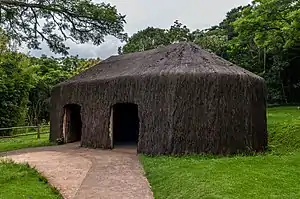
Kamaiurá oca
Oca is the name given to the typical Brazilian indigenous housing. The term comes from the Tupi-Guarani language family.
They are large buildings, serving as collective housing for several families,[1] and may reach 40 m (130 ft) in length.[2] They are built through joint effort over one week, with a wooden structure and bamboo and straw cover or palm leaves. They can last up to 15 years. They have no internal divisions or windows, only a few doors.
See also
References and notes
- General
- COP8/MOP3, 16 March 2003. Amanhã, cerimônia ao pôr do sol inaugura ocas Xavante, by Marina Koçouski.
- Arte Indígena
- Citations
- ↑ "Diferentes Moradias" (PDF). Educacional (in Portuguese). Retrieved 13 October 2016.
- ↑ "Conhecendo uma oca". Sua Pesquisa (in Portuguese). Retrieved 8 October 2016.
This article is issued from Wikipedia. The text is licensed under Creative Commons - Attribution - Sharealike. Additional terms may apply for the media files.

